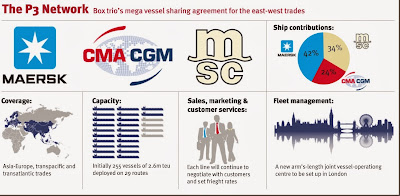The
announcement of setting up of The Mega P3
Alliance by Maersk, MSC
& CMA CGM literally stirred up the shipping community as a whole. The P3
network is expected to commence from the 2nd quarter of 2014. Assuming regulatory hurdles are overcome, the P3 network will cover the
three trade lanes of Asia-Europe, transpacific and transatlantic, using the
existing capacities of each member. The network
is estimated to have a market share of about 42%on the Asia-Europe trade, 24 % on the transpacific and 40% on the
transatlantic trade.
An independent operating centre will be set up in London to manage the P3
network, responsible for ensuring that each line's schedule integrity is
maintained at a high level. The centre will be headed by former Maersk Trade
Manager Lars Michael Jensen. The working style of MSC is different from Maersk
& CMACGM and it is to be seen how the mega carriers perform together.
The
P3 Alliance will first deploy 255 vessels with a capacity of 2.6 million TEU,
operating across 29 separate loops. Maersk
will contribute 42% of the capacity, MSC
with 34%, and CMA CGM with 24%. Vessels provided by the lines will continue to
be owned and chartered individually by the carriers. Also, they would
be allowed to trim down sailings during the low seasons and might
add extra loaders at times of high demand.
As per the reports , the P3 Network partners have still not agreed on
which port will serve as the key hub in Southeast Asia . According to analysts
SeaIntel, choosing a key port in Southeast Asia is very important and one of
the major challenges for Alliance, as cargo from countries such as Indonesia,
the Philippines, Vietnam, and Thailand is distributed further through the three
key ports currently used by each carrier. For Maersk Line this port is Tanjung
Pelepas and for CMA CGM it's Port Kelang, also in Malaysia, while MSC is using
Singapore.
The announcement of the P3 Alliance has been both applauded as the
solution to the over-capacity situation in the global ocean liner trade and
despised as a monopoly cartel devised by the world's three largest container
carriers. In reality, it is somewhere in between those two extremes. However, P3 alliance hopes to
reverse the downward financial trend by deploying most suitable vessels ,
avoiding duplicate trips and cutting fuel costs.
